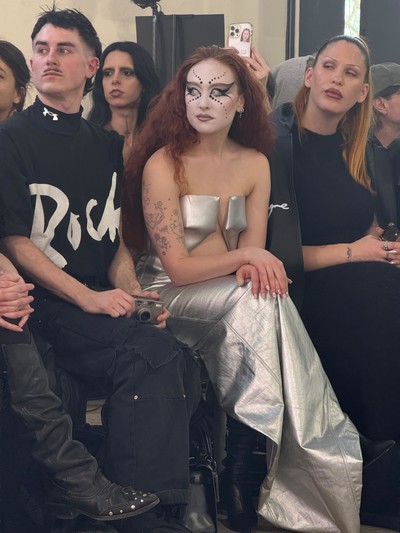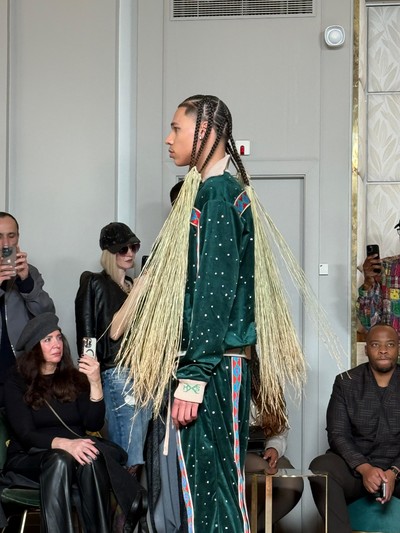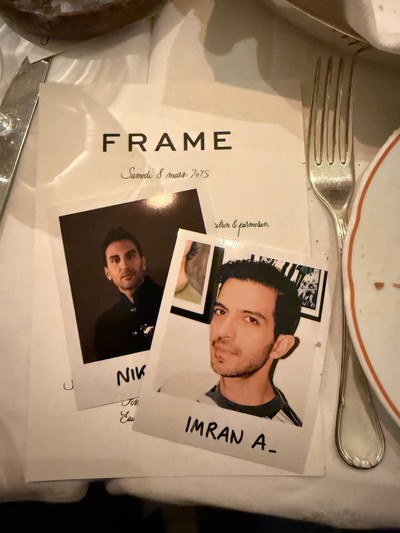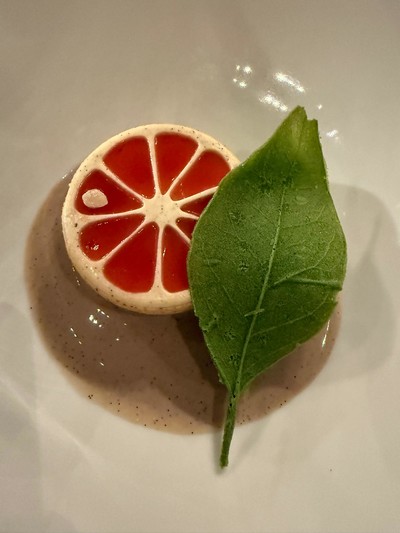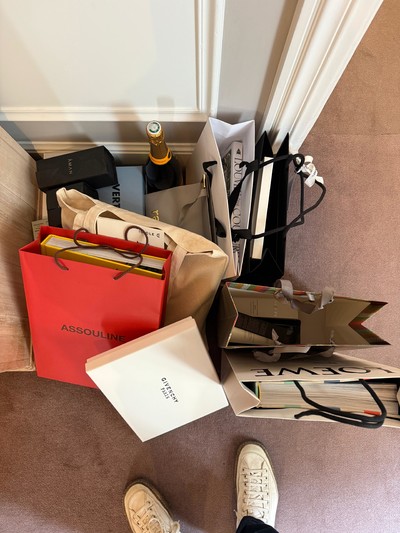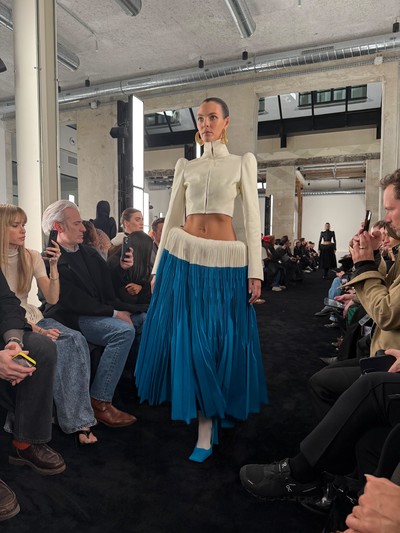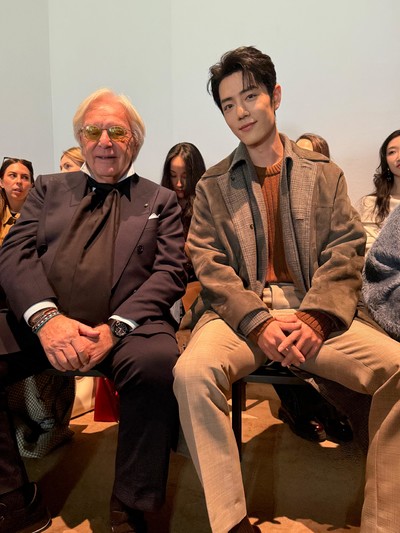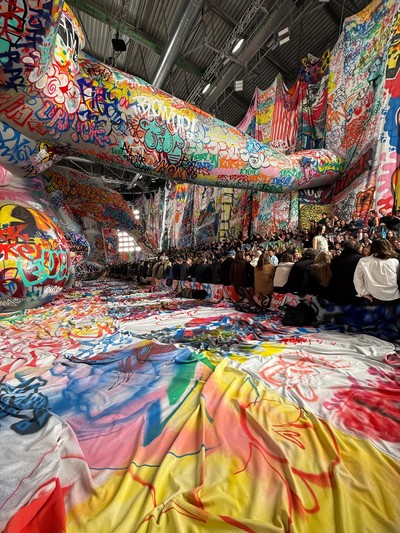Interview by Jonathan Wingfield
‘In a world where nationalism rises and globalization unwinds, luxury fashion, as a symbol of cross-border aspiration, could face its greatest test in decades.’
Since 2007, Imran Amed has transformed his blog, The Business of Fashion, into a ubiquitous industry resource and global media business – along the way becoming one of fashion’s most trusted and influential voices. A regular BoF contributor, Luca Solca is also one of the most respected equity analysts in the luxury goods sector, and since 2019, has been Senior Analyst of global luxury goods at Bernstein, based in Geneva.
In the following conversation with the pair, Imran and Luca bring a sharp, analytical and data-driven lens to this season’s shows and the industry’s many shifts. They unpack what the numbers reveal, what the mood suggests, and how fashion is positioning itself for what comes next, all in the shadow of looming trade policy changes with potentially far-reaching consequences.
Jonathan Wingfield: Since the three of us last spoke together, the global landscape has shifted dramatically. Back in 2023, Bernard Arnault was the world’s richest man, China’s luxury boom was peaking, and America felt relatively stable. What current world events or economic shifts are having the biggest impact on fashion right now?
Luca Solca: One of the most important factors has been the fall of the real estate market in China. This has caused a huge dent in Chinese consumer confidence and kept consumers on the back foot, as they’ve all felt poorer. They saved a lot of money – and they’re still saving, not committing to discretionary spending as enthusiastically as they have in the past, and definitely not showing the same drive to enjoy life that people in Europe or the US have shown coming out of the pandemic. I think this has been, by far, the most important factor.
Did the housing crash in China feel inevitable to you, or did it come as more of a surprise, making the knock-on effects just as unexpected?
Luca: The affordability was very stretched, so it was a surprise to an extent. The writing was on the wall that, at some stage, the market would have to correct. We’ve seen crises like this in other countries as well: in smaller economies like Spain, and in larger ones like Japan. I believed that at one point, push was going to come to shove – and so it did. So, not a big surprise, but clearly a major factor that luxury goods brands have had to adjust to nonetheless. They’ve tried, I think, several ways to address this issue, for example, by becoming far more relevant to rich consumers. I think in the past five years there’s been significant development of this consumer cohort. And by focusing on the US as a growth market – previously kept on the back burner and treated as a second priority – this shift now seems to be working to a large extent, albeit with 2024’s industry growth feeling somewhat like an atonement for the exceptional growth of previous years.
‘Customers in the US and Europe are now trading off their spending on luxury goods with other things: travel, dining, health and wellness…’
Given your role at Business of Fashion, Imran, which is all about decoding markets and offering real insight to the industry, how are you reading the situation?
Imran Amed: On the China phenomenon, the one thing I would add to what Luca has said is that a big part of the issue is that something like 80% of the wealth in China is tied to real estate. So when you have a real estate crash – or correction – imagine if any of us had 80% of our net wealth locked up in property and suddenly saw its value drop pretty precipitously. That would obviously impact our overall sense of confidence. The degree to which this has affected the Chinese consumer is really interesting. Alongside that, as Luca alluded to, Chinese customers are still saving money. Because they don’t have confidence in the value of their real estate portfolios, they’re not spending as much. So what’s happening now is the savings rate is growing – which means that, at some point, there may be an opportunity down the road to unlock some of that value.
Luca: The only thing is once Chinese consumers digest the new value of their property, and if property prices were to find support, there’s a lot of money they’ve kept on the sidelines that they could go out and spend. So I wouldn’t write off the Chinese consumer cohort with a medium-term view. That said, this recovery is probably going to be U-shaped.
Imran: They’re going to spend again, but what are they going to spend on? That brings me to my next point. I think what we’ve seen in the industry around the world, after what you might call the ‘pandemic gorging’ of luxury goods – when there were no other options but to spend on luxury products – is a shift. Customers in other parts of the world, in the United States and Europe, are now trading off their spending on luxury goods with other things: travel, dining, health and wellness, and other experiences. I think this is the longer-term force the industry has to grapple with. There was a short period after Covid when everyone was consuming like crazy – that was an aberration. A temporary spike. But many luxury brands began planning and operating as if that surge would continue. They made decisions that are now coming back to bite them – most notably, raising prices. So when customers are now making those trade-offs and looking at a €10,000 bag that used to cost half of that, there’s real pressure. The value proposition just doesn’t add up. And when you combine that with the fact that those €10,000 products are being made in the hundreds of thousands – or even millions – there’s a lack of differentiation. People are wondering: ‘Why would I spend so much on something everyone else has?’ This has forced brands to focus more closely on delivering something different, especially for the particularly important 2-5% of luxury customers who drive 30-40% of industry revenues. There’s a lot that happened during the post-pandemic surge that the industry is now being forced to reckon with.
‘The combination of pricing, mass-produced luxury goods, and questions around ethics and supply chains is a lot for the industry to contend with.’
You mentioned a shift towards more experiential spending, but could there be a broader sense of luxury fatigue – one that might mean demand doesn’t return as voraciously as before?
Imran: I think there is fatigue. I would go so far as to call it, in some cases, a rejection of the luxury model. For some customers it just doesn’t make sense anymore. The combination of pricing, mass-produced luxury goods, and questions around ethics and supply chains is a lot to contend with. Then you have the extraordinary margins some of these brands are earning on potentially less-than-ethical manufacturing practices – some of which were exposed in the Italian investigation last year. There are a lot of factors at play, and I think in some cases customers are saying: ‘I just don’t buy this anymore.’ It goes deeper than fatigue – it’s a rejection of the model altogether.
Luca: I’m not sure I would fully agree here. I think there’s definitely a lot of homework that luxury goods companies need to do. In the post-Covid boom they were so busy making money and trying to satisfy demand that they focused on raising prices to balance supply and demand – but they forgot to update and upgrade their styles. They let gross margins explode. That definitely can’t go on. We’ve already seen the best brands start tackling these issues. Just look at the Vuitton windows – now, magically, the bags on display are all between €2,000 and €3,000, which is where they should be. At the same time, we’ve seen a huge amount of musical chairs when it comes to creative directors. People want newness. If they’re paying these prices, they want to be excited. They want to feel like they don’t already own the product, that they haven’t seen it before – and that they desire it. I think this musical-chairs game will only continue. We’ve already seen a significant number of creative directors being excused and a significant number being appointed. Coming from deep inside the industry and with a lot of sophisticated knowledge about the model, I’m not sure we should necessarily project our own understanding of the market onto the broader consumer audience. Consumers still like and embrace luxury goods. I have been invited to a debate on whether the luxury-goods crisis is structural, and one of the points I’m making in arguing that it’s cyclical is this: the first luxury item ever found – discovered in a cave in Essaouira, Morocco – was a shell necklace dating back 140,000 years. Things can change, of course, but there is a deep-rooted human appreciation for products that enhance appearance, signal status, and offer a sense of identity. I don’t believe that will ever fully go away.
Imran: Where Luca and I are aligned is in the idea that the industry’s new focus has to be on creativity and innovation, and that’s been sorely lacking in recent years. Not only have product ranges stagnated in many cases, but the way brands engage with customers and communicate about luxury has become formulaic. One of the reasons I’m so excited about the coming months in fashion is because I keep thinking ahead to Spring/Summer 2026 fashion week, when we’ll see so many new creative debuts – whether it’s Matthieu Blazy at Chanel, Demna at Gucci, possible changes at Dior, or new designers at Jil Sander, Versace and numerous others. It seems that brands are finally coming around to the fact that they need to inject fresh creative energy into these houses to reignite customer excitement. What I’m not convinced about is the industry’s current approach to pricing, or its handling of ethical questions and structural practices over the past five to 10 years. I think those areas need more than surface-level changes. We may be approaching a genuine inflection point and for anyone like Luca or myself, whose job revolves around analyzing all of this, it’s going to be a very interesting time.
Luca: I agree with you on that point, too. Pricing needs to be corrected. Part of that involves projecting higher value on the products being sold – whether that’s through using better materials, offering more functionality, or giving consumers more perceived utility. For example, Vuitton’s reversible Neverfull bag gives people the impression they’re getting two bags in one. But there’s also a huge amount of work to be done in introducing new entry-price products. Prices have gone to heaven and they can’t stay there if you want to serve people who live on Earth. Dior’s new bags are a step in the right direction. Meanwhile, jewellery has become more attractive in terms of value for money, because prices didn’t rise as sharply – so it feels more accessible today. I wonder whether soft-luxury brands will eventually wake up and adjust their multiples back to where they need to be. I think eight to 12 times was rich enough. And I also agree with Imran that after a lot of lip service around craftsmanship, ethics, and sustainability, far more needs to be done in terms of upstream manufacturing integration. If brands want their marketing narratives to actually be believable, they certainly need to live up to them operationally. And so I think this is the shape of things to come in the short-to-mid-term.
‘In some cases, customers are saying: ‘I just don’t buy this anymore.’ It goes deeper than luxury fatigue – it’s a rejection of the model altogether.’
Do you think brands need to meaningfully rethink how they operate? Not necessarily from an ethical standpoint, but from a purely operational one.
Luca: You know, these companies are run by human beings and if you don’t give people incentives to change, they won’t. If you’re making as much money as you like, and business is as good as it’s ever been, then you probably won’t change very much. I think adjusting to a more normal environment is prompting a lot of soul-searching and is bringing these companies back in line. This is absolutely appropriate and I couldn’t agree more with Imran: the post-pandemic boom was fuelled by the sense that we were all just happy to have survived. We wanted to enjoy life and spending money was no longer a problem. Everyone had the mindset of ‘let’s enjoy it while it lasts – nobody wants to be the richest person in the graveyard.’ But that euphoria has been dying down. People are getting back into the swing of things. They’re no longer fearing that they’ll die tomorrow, and as a consequence, they’ve returned to a more normal level of discretionary spending. That shift demands a lot more effort from companies – not just in luxury, but across industries. I read recently that in New York some people have gone on a restaurant ‘strike’ because prices had gone up so much and the quality didn’t match. There was a bit of widespread overexcitement, and now that needs to be reined in. People need to come back to planet Earth.
Imran: Operationally, what that means is that we’re now talking about a game – an industry where people are fighting for market share. They can’t just ride the wave of widespread industry growth anymore, where a rising tide lifts all boats. The tide is still right now, which means that to grow, you need to do something different. You need to find ways to take market share from existing players. There are definitely examples of brands doing just that. Growing steadily, and in some cases, astronomically, despite the sluggish environment. Look at Hermès, Loro Piana, Brunello Cucinelli – brands offering something that still resonates deeply with customers. Or Miu Miu, which is growing 80-90% year-on-year, even in a sector with very slow overall growth. That kind of performance would be impressive in a booming market, so seeing it now tells you something. It shows that customers are still being drawn to certain kinds of brands for specific reasons. I was speaking with a luxury department store executive late last year about the quiet luxury phenomenon and whether it’s here to stay. He broke it down nicely: in the men’s market, quiet luxury is still booming. Men tend to buy in multiples – once they find something they like, they’ll buy it again and again, in different colours or styles. But in the women’s market, quiet luxury is on the decline. There’s a return to maximalism, to expression. Women are once again looking for something different, something more interesting. And this is where all the creative innovation we talked about earlier really comes into play. Some brands are succeeding operationally, but it’s because they’re winning market share from their competitors.
‘I don’t think Gucci can afford a complete overhaul and I don’t think Kering can afford to commit huge investments before we see a turnaround.’
For large-scale luxury fashion brands, what happens when you’re posting results that are down by 20%? How do you weather that storm? One option is to go after market share – but from an operational, logistical, and financial perspective, do you sense that brands are being forced to make deeper cuts?
Imran: Absolutely. There are brands out there significantly cutting their store footprint. I think Gucci is one of the brands in China that’s paring back. Someone told me that something like 50 Gucci stores in China are going to be closed. You can also see it in how brands are adjusting their budgets for discretionary spending. Fashion shows are getting smaller. Yes, for intimacy, but also because they cost less to stage. Over the past few months we’ve seen a number of brands combine their men’s and women’s shows – realizing that their earlier decision to separate them may not have been the right strategic move. A unified perspective allows them to cut costs more effectively. I think a lot of what we’re seeing right now is a reflection of that. Brands are actively looking for ways to streamline and save.
Luca: Totally. You have to take into account that a lot of the costs in this industry are fixed. The cost of goods sold – the variable element – is relatively small. So when sales decline by as much as 20%, you really need to cut the fixed part of your cost base, which means rental costs and your own organization. And when it comes to discretionary spending, you have to tone that down as well. We’ve seen major events shrink and I suspect we’ll see a lot of ‘intimacy’, as Imran said, being used as a rationale to bring costs back in line. But if you look at a brand like Gucci, it has still been somewhat protected at the bottom line. Operating profit margins have dropped – from the high 30s down to the low 20s – and unfortunately, that’s the operating leverage of this industry kicking into reverse.
On one hand, we’ve seen a cooling of the Chinese market. On the other, President Trump’s government seems to be turning its back on Europe. Do you think that shift affects the psyche of the American consumer when it comes to luxury fashion? And does it, in some way, undermine the strength of the ‘Made in Europe’ brand?
Luca: There’s a risk of nationalism, which I think is the most important risk here – more than tariffs. Not only in America but in China as well, and in other parts of the world, nationalism could rise to a level where anything that comes from abroad, anything that is foreign, becomes bad by definition. Hopefully we’re not going to go there, because the moment we go there, we could potentially be in the antechamber of war. But the risk is definitely there and it is quite clear that luxury is a global industry that has thrived on the back of markets opening up, on the back of globalization, and on the back of more countries participating in the global economy, benefiting by increasing their GDP and creating audiences for luxury goods. So I think it’s the nationalist element that’s the most potentially dangerous. Import tariffs, even if they were at the 25% that President Trump has mentioned, need to be considered in the context that luxury-goods companies would be selling to their own American companies at transfer price, and transfer price would, in most cases, be wholesale. Wholesale is 40 cents to the dollar, so even a 25% additional import duty would mean another 10 cents, which could potentially be offset by increasing retail prices by 10%. Not ideal, for sure, but not the end of the world either. So, import duties are less of a concern than what a nationalist escalation could potentially bring.
Imran: I think along with that escalation, my one observation in having seen the dynamics around this emerging trade war over the last few weeks has been that sometimes things move irrationally. Just the other day, in response to the EU responding to American tariffs on steel, President Trump said he was going to put the tariffs on European spirits and champagne to 200%. You’re getting to this point where people are using these tariffs as bargaining chips as part of a very complex negotiating strategy, but it can get out of hand. Notwithstanding some of the kind of caveats that Luca has rightfully put forward, I just worry that we’re entering this period where things are going to become irrational. And when you try negotiating with irrational people, you often don’t get a good outcome. As a Canadian, I’ve been watching everything that’s been happening. Canadians are not the most patriotic bunch of people. I’ve never seen a strong nationalistic surge in Canada since Quebec tried to separate from Canada in 1995. It’s the only time I’ve seen Canadians waving flags and, around the country, professing their love for our country – which we’re all very proud of but we’re very quiet about. But now my mom is sending me text messages about not buying anything American, not wanting to travel to America – you really see this surge has happened across the country. I think there is this sense of pride. So we’re going to really have to monitor how this all develops.
‘Gucci has been relevant to consumers in the past 25 years when it was over-the-top. Demna could provide this twist and disruptive element.’
Imran, you’ve just returned from the Autumn/Winter 2025 fashion shows, would you say this uncertainty has been felt on the runway this season? Did you sense much direct response to world affairs or industry turbulence?
Imran: Obviously, there were two important debuts this season – not at brands of the same scale or note as Gucci, Chanel, or Dior, but at Givenchy, an under-loved, neglected brand within the LVMH portfolio, and at Tom Ford, which is a big beauty business with a small fashion arm. Both of those debuts had such creative and emotional resonance for those of us who attend 40 to 100 fashion shows in a season. It genuinely brought my love for fashion back. So many shows I’ve been going to lately feel like designers are churning out the same heavily merchandised collections, focused on copycat luxury products that aren’t distinctive. But when you see designers like Haider Ackermann and Sarah Burton – two very talented designers – bring real thinking, emotion, and consideration into what brands like Givenchy and Tom Ford can stand for in the context we’re all operating in now, there was absolutely a sense that the catwalks were responding. If that kind of effort, thoughtfulness, emotion, and love is put into the collections we see over the rest of the year, I think the industry could see a real surge of creative excitement.
In our 2023 interview, Imran, you said: ‘I think a brand’s creative strategy is a function of its business strategy.’ Would you say the current business strategy is one of survival, cost-cutting, or regrowth? And how might that translate into creative direction?
Imran: I think it goes back to the point I raised earlier about market share. When you’re trying to win market share, you have to find a basis for competition – and I think many brands will be competing on creativity and innovation. Some of those brands are doing that while continuing to grow. Others are trying to execute a turnaround. Some, like Hermès, are focused on maintaining steady growth. Not every brand is going to approach the fight for market share in the same way. I think one general rule is this: there will be a renewed focus on creativity, design, innovation, and quality. These are the factors that influence how a customer evaluates the value ratio between price and product. They’ll be asking: ‘How unique is the design? How well is it made? How available is it to others?’ Essentially, ‘How special is the product I’m being asked to buy vis-à-vis the price I’m being asked to pay?’ And where that ratio makes sense to people, they’ll buy. Where it doesn’t, they won’t.
‘Look at Miu Miu today: incredibly successful, right in the sweet spot, but because of that visibility, they risk tiring the market in a year or two.’
Luca, Kering’s cash cow, Gucci, has been operating at a particularly significant loss. How much of an existential crisis does this represent to the entire Kering group?
Luca: It’s difficult to understate how big this problem is for Kering. Gucci has to come back and it has to come back sooner rather than later – especially at a juncture where Kering is committed to very significant M&A [mergers and acquisitions] with the acquisition of Creed, the acquisition of Valentino, and also very significant real estate investments. And also at a time when the smaller brands like Saint Laurent and Bottega Veneta probably need to go back to the drawing board. There was this idea that they would need to produce operating profit margins in the 30s, but in order to get to that level with their relatively small size they had to cut a lot of corners. And in today’s market, you cannot cut corners. You need to execute properly when it comes to the quality of your flagships, the quality of your products, and the amount of money you commit to your communication and marketing budgets. This is a fight for attention, and in communication what counts is the sheer amount of money you bring – so you cannot be saving on that. This is a very important turning point for Kering, which is why there was so much attention on the new creative director appointment at Gucci, and why I think the market today is expressing some disappointment about the name that has been brought forward. Also because, to some extent, Kering’s share price had started to rise on the back of hopes that the appointment would be more convincing and that the change might open up an opportunity for Gucci to improve. Markets react very quickly to good news. Look at what’s happened to Burberry’s share price since September last year: a new CEO came on board, a new strategy was announced, it made sense, new communication was brought to market, which also sounded convincing. The share price has doubled on the back of the promise that this is all going to work. Here, the promise doesn’t seem particularly convincing, and the share price is down today because I think the market in general is thinking: maybe this is not a good fit. The Business of Fashion was carrying out a survey on Instagram and I think the outcome of that survey – whether Demna is the right creative director for Gucci or not – at least in the minds of the 9,000 people who responded, seems to be very clear.
Imran: It’s interesting – I’ve written an editor’s letter which will go out tomorrow morning that addresses this very topic. I talk about the market plunge; I talk about the survey on Instagram. But having reflected a little more on the decision to appoint Demna, I understand where Kering is going. There are so few designers in the industry who are available, who have the proven ability to transform a brand, who have name recognition in the industry, and who have the calibre of experience that Demna has – from Margiela, to Louis Vuitton, where he worked alongside Marc Jacobs and Nicolas Ghesquière, to launching a startup like Vetements that disrupted the industry, and transforming Balenciaga into a multi-billion-euro brand. The fact that Demna is already inside the group means they could take him without having to deal with pesky non-compete clauses that might slow their progress. So even though he’s working on a couture show for Balenciaga in July, he can still be developing his plans for Gucci. Hopefully that means they can bring something to market soon. And when you consider all of these factors, I think the real test for Kering – and I agree with Luca that this is something of an existential choice – is whether Demna can move his aesthetic and design sensibility beyond what he’s become known for at Vetements and Balenciaga. That, for me, is the fundamental question here. And having spent time with Demna over the last 10 or 12 years, since he first burst onto the scene, I truly believe he’s a designer with real ability. He’s one of the most thoughtful, most talented, and most provocative designers we have in our industry. We’re lucky to have him. So the question is: can he deliver the goods? Can he change Gucci, and can he change himself? That’s what this all rests on.
In parallel to Demna’s creative input do you think there’ll be a need for significant investment – both from Kering and from Gucci – to allow what could be quite a radical new vision to fully take shape and succeed? Not just in terms of communication, but in a deeper, more structural way. Would stores need to be redesigned, refitted, along with all the other costs that come with this kind of creative reboot?
Luca: I think that at this particular juncture, they will have to be very pragmatic and very practical. I don’t think Gucci can afford a complete overhaul and I don’t think Kering can afford to commit huge investments before we see a turnaround. If things play out in the right direction, there must be a way to re-energize consumer interest in Gucci without committing too much capital at this stage, because capital is short. I agree with Imran: even before we look at the stores, we need to consider what kind of new aesthetic Demna is going to bring, and whether that will have the power to add a twist to Gucci. I think what was missing under Sabato was precisely that twist. Gucci has been relevant to consumers in the past 25 years when it was over-the-top, in one way or the other. Even if this is once again an abrupt move in terms of how and where Gucci needs to go, Demna is someone who could potentially provide this twist and disruptive element. He definitely did so in spades at Balenciaga and what he was doing back then resonated enormously with the market. His approach was to use irony and a sort of iconoclastic approach – think about the Ikea bags, or the garbage handbag he launched. It reminded me, to some extent, of Moschino and the irony within that brand. He also used a lot of streetwear. I don’t know if either of those two approaches would be relevant for Gucci today. Gucci is very big and I don’t think that being visible through something iconoclastic is necessarily the right recipe to make Gucci relevant again. And my impression is that streetwear is yesterday’s story, so he will need to invent something new. That is why creative directors have such an important role in our industry and why they’re paid so much. At the end of the day, this is the challenge ahead. Then, once the heat comes back, we can talk about everything else. We can talk about making the stores nicer, communication, whatever, but first the heat has to return to the brand and the organic decline has to be stemmed if Gucci is to have a chance to play in the top tier.
‘Brands are finally coming around to the fact that they need to inject fresh creative energy into these houses to reignite customer excitement.’
Let’s turn our attention to the other group, LVMH, for a moment. I read a Bloomberg article on BoF last month in which the writer explored the possibility of Louis Vuitton splitting and becoming a separate entity from LVMH, to increase the overall market value. Tell me more about that.
Imran: I think it’s less about separating Louis Vuitton from LVMH, and more about refining the overall portfolio and removing some of the underperforming businesses that are dragging down margins for the core LVMH group. I’d be surprised if Mr. Arnault – at least while he’s still in charge of the brand, possibly until the age of 85 – would take Louis Vuitton out, spin it off, and separate it from the group. I very much doubt that would be a good strategy. However, there are underperforming parts of the group, particularly in the selective retailing category – like DFS, the duty-free stores, which have traditionally been built around the travelling Chinese tourist customer. That segment is struggling, as we all know, with far less travel happening than before. I’ll also be very curious to see what happens with the Wine & Spirits division at LVMH, which is now run by former CFO Jean-Jacques Guiony and Mr. Arnault’s third eldest child, Alexandre Arnault. Some people are suggesting that Guiony’s appointment could indicate an eventual plan to take that division out of the business altogether, especially given the structural shifts happening in the alcohol sector where many people – especially younger consumers – are drinking less. So, while I don’t think we’ll see Louis Vuitton removed from the LVMH group, I do think it’s possible that some other parts of the business might be spun off or divested in a more strategic, opportunistic way, particularly if they’re weighing down margins. I think the markets would reward that but I’m not the market expert, that’s Luca. I’m curious, Luca, what your take is on the potential for structural change within the group?
Luca: Indeed, we were, as Imran pointed out, writing about the opportunity LVMH has to spin off the Wines & Spirits business, in the same way Richemont spun off its tobacco assets in 2008. The idea would be to place those assets into a special-purpose vehicle that’s publicly traded. You put the Moët Hennessy assets into it and then distribute the shares to LVMH shareholders proportionally, based on their ownership of LVMH. This way, if shareholders like, they can keep the shares in their portfolio; I presume the Arnault family would do so. But I also presume many other investors would choose not to, potentially selling their shares, allowing controlling shareholders to gain an even bigger stake and to potentially split that business between themselves down the road. The advantage of this approach is that Wines & Spirits is not only underperforming, but also operates under a completely different logic. It’s entirely wholesale driven, focused on maintaining product consistency rather than newness. What they aim to do is maintain the taste of the champagne and the cognac year on year, blending as necessary to ensure consistency, while innovation is primarily in packaging. It’s a very different setup. When it comes to communication, it’s the heart and soul of Fashion & Leather Goods, whereas, in many markets, advertising is prohibited for spirits. Again, very different logics, no synergies, and not even a clear advantage from diversification. Maybe fifteen years ago, there was this idea that both Wines & Spirits and Fashion & Leather Goods would contribute similarly to the group’s profits. But today Fashion & Leather Goods is very big, while Wines & Spirits is comparatively small, so this diversification no longer exists. Additionally, the presence of spirits prevents many investors, particularly those in the Middle East or in the ESG [Environmental, Social, and Governance] camp, from buying shares. So, where is the advantage? I agree with Imran. What triggered this discussion, and the reason why we wanted to be upfront about this logic, is the appointment of Jean-Jacques Guiony as head of this business. His capability as an M&A architect and CFO is unquestioned. So I wonder if, perhaps with a slightly better consumer demand environment, this could become a priority. As far as the rest is concerned, I agree that potentially selling DFS, which has been clocking significant losses, would be a very good idea, while investing to consolidate that triangular force of Fashion & Leather Goods, Fragrances & Beauty, and Selective Retail – in particular, Sephora – which acts as an accelerator for Dior Parfums, Givenchy, and any future beauty brands LVMH might consider acquiring.
Chanel doesn’t necessarily need to grow at the same rate as the LVMH fashion brands because it is not a public company. Tod’s Group has delisted the company from the Milan Stock Exchange with help from L Catterton. To the layperson reading this, what are the pros and cons today of a luxury fashion business trading publicly or remaining a private enterprise?
Luca: I don’t think it’s the fact that you’re public that forces you to grow. I think it’s the fact that this is a fixed-cost industry that forces you to grow if you want to remain a protagonist in the industry. You could stay very small, but in the end, you’re going to risk becoming a high-quality acquisition target, which is exactly why Hermès, since 2008, has been so eager to accelerate its growth. If it becomes big enough, it will not only avoid being a potential acquisition target but will also have the funds and resources required to compete on emerging new fronts. If you’re big, you can expand competition to new levels: sponsoring the Olympics, real-estate spending sprees, Formula One sponsorships. If you’re small, you’ll become invisible because you can’t match what the industry leaders are doing – bigger flagships, social-media presence, influencers, itinerant couture, and pre-collection shows – every day there’s something new to spend money on. If you’re small, you’re dead. At best, if you’re truly differentiated, you can be a high-quality niche player, like Cucinelli or perhaps Moncler. But if you’re mainstream, it’s difficult – as Ferragamo illustrates – to stand out and justify your place in the market. That primarily stems from a huge, escalating scale disadvantage. So that’s my two cents. Even the biggest players, like Chanel, simply cannot afford to scale back to 15 or 10 billion euros, thinking ‘we’re good, we’re a private company, we don’t care.’ No, you won’t be able to compete if you’re not in the same league.
Imran: Scale really matters for all the reasons Luca mentions. However, when you’re privately run, you can operate your company differently, which I think is the important benefit to highlight. So, if you’re Chanel and the Wertheimer family, you certainly want to grow your business and make money for all the reasons Luca mentioned, but you can take a much longer-term view. I know many CEOs – like former CEOs of Burberry, and Diego Della Valle of Tod’s Group – are frustrated by how quarterly market reports impact their decision-making. Without analysts like Luca reviewing your performance quarterly, you can make decisions with a medium- or long-term mindset rather than a short-term one. Diego Della Valle, I’m pretty sure, delisted the company and partnered with L Catterton to adopt a longer-term perspective because he felt they’d better understand his business. But even L Catterton will definitely want that business to grow – they’ll expect a return, too. That’s the only thing I’d really add.
‘For an industry already navigating inflation, shifting consumer habits, and disrupted supply chains, the tariffs introduce yet another layer of uncertainty.’
We’ve touched on Chanel, Hermès, Vuitton, Dior, and Gucci – the kings of the industry. Do you think a mid-sized or smaller brand could ever catch up and operate at that scale? Or have these giant houses now separated themselves to such a degree that they’re effectively playing a different game – almost operating in a different industry entirely – compared to brands like Bottega, Loewe, or Celine?
Luca: That’s a very good question. There’s no evidence of it. We wrote a black book about the challenger’s dilemma. At one point, Kering seemed able to challenge the leaders by growing faster, but this growth brought greater visibility and significantly higher risks, such as consumer fatigue or needing to cut corners to maintain momentum. At the peak of Gucci’s boom, Monsieur Pinault indeed spoke of Gucci potentially catching up to Vuitton – we remember all that distinctly. It’s very difficult because the industry’s nature demands exclusivity, or perceived exclusivity. Think about Miu Miu today: incredibly successful, right in the sweet spot, but precisely because of that visibility, they risk quickly tiring the market in a year or two. We’ve seen this repeatedly. Smaller brands strike gold – think Phoebe Philo’s Céline, among others – but eventually succumb to their own success. They become too visible, and consumers move elsewhere. They tend to be a flash in the pan or hit a glass ceiling, today around two or three billion euros, which is extremely challenging to break through.
Imran: I think it’s very tough, honestly. Once you have scale, you have built-in advantages. Trying to achieve scale when dominant players control the best retail locations, lock in prime advertising placements, buy in bulk, and work with top talent creates huge barriers. The scale that big brands have established makes it very difficult for newer players to compete. I look at smaller, disruptive businesses like Jacquemus, which quickly grew into a €250-300 million business but then hit a ceiling and needed additional capital to continue growing. Brands consistently face ceilings at different points – €10 million, €50 million, €250 million, €1 billion, even €10 billion, as we see with Gucci. Continuing to scale a fashion brand is extremely challenging and very few businesses have proven able to do it. I’ve talked with people at Vuitton about how big their business could become, and perhaps there’s a ceiling where further growth would only make the brand too available, too visible, too ubiquitous – and thus less desirable.
Luca, when you mentioned LVMH’s Wine & Spirits sector earlier, you rightly pointed out that younger generations relate to alcohol – and the allure of champagne and spirits brands – very differently than previous ones. Do you think that same generational shift could apply to luxury fashion?
Luca: We carried out an in-depth study of how Gen Z consumers use their spare time, how they’re behaving, and how they’re feeling. It was interesting to see that these younger consumers spend significantly less time with their peers and don’t have, proportionally, the same social experiences as people did 20 or 30 years ago – like going out, being part of a community, joining a political party, or having a boyfriend or girlfriend. Across the board, those numbers were lower. Interestingly, there was also a very fragile sense of identity, and responses to the question ‘Are you satisfied with yourself?’ scored significantly lower than in the past. To some extent, the level of exposure that social media brings is corrosive to that sense of identity. In this respect, I think luxury brands could actually become even more relevant today because, by my definition, they function as a kind of identity crutch. You can look better because you own a certain brand’s product and that helps support your sense of self – who you are and how you’re perceived within your community. I think this has made the aspiration to luxury broader and more universal than ever. So, in that respect, I’m actually a bit more relaxed. When it comes to affordability, we need to consider several converging factors that help explain how people continue to buy luxury goods despite price inflation. People are marrying later, which allows them to piggyback on their parents for board and lodging longer, giving them more freedom to spend their income on discretionary products and services. There’s also been significant ‘de-averaging’ in the economy through discount alternatives – think budget airlines, Walmart, or anything that helps people save money. Then there’s the rise of the sharing economy: capital expenditures like buying a car are no longer top priorities for younger consumers. Finally, there’s a substantial inheritance effect, with younger generations set to receive wealth at a time when, in most countries, populations are declining, further concentrating wealth. Taking all of those factors into account, I feel quite confident that the foundation for luxury to grow and remain relevant is still very much there.
Last question to you, Imran. It’s one you ask industry figures you interview, so I wanted to turn it back on you. What does success look like for a luxury fashion brand in the current climate?
Imran: I was having this debate with the CEO of a brand at a dinner we hosted the other night with McKinsey regarding our State of Fashion 2025 report. For me, it’s about alignment and clarity around strategy. Previously, you referenced a comment I made during our 2023 conversation about how creative strategy is a function of business strategy; I think the reverse is also true – business strategy is a function of creative strategy. Where brands work best is when there’s impeccable alignment between the creative leadership and business leadership. I’ve seen this yo-yo a lot over my time in fashion. When I first arrived in this industry back in 2007 and met creative and business people, I sensed that the creative people tended to look down their noses at the business side, believing commercial aspects should always be downstream from creative decisions. Recently, though, the pendulum has swung the other way – the business side is increasingly dictating fundamental creative decisions. Decisions are made based on what’s happening in the market, what retailers are asking for, or what seems to be working at other brands. For example, you’ll hear, ‘This brand has a bag of this shape that’s doing really well because I heard it from department-store executives, so we need to have a bag of the same shape.’ This has led to everything looking the same. What I think it takes to be truly successful in this current climate is having that lockstep alignment, clarity, and synergy between the creative and business sides of fashion. Strategy needs to come from both sides sitting together and asking, ‘How do we create something genuinely special?’ In the rare cases where there’s this alignment between a CEO and a creative director, it’s pretty magical. Right now, though, when you talk to creative directors in the industry, that’s not how they feel. They feel like decisions and creativity are dictated to them rather than discussed collaboratively. Earlier, we were talking about all those exciting debuts, but for them to work, they’ll require a strong synergy between creative and business leadership at the brands making these changes.
‘Nationalism could rise to a level where anything foreign becomes bad by definition. If we go there, we could potentially be in the antechamber of war.’
Postscript: A rapidly shifting global trade landscape
Since this conversation was recorded in mid-March, the global context for fashion has shifted significantly. On April 2nd, US President Donald Trump announced a sweeping set of new tariffs aimed at reducing America’s trade deficit. And then on the 9th, they were paused for 90 days. The move has triggered a sharp escalation in global trade tensions, with retaliatory responses from China already in place and similar measures being considered by the EU. For an industry deeply reliant on cross-border production and international sourcing, these developments are more than policy adjustments – they signal a potential upheaval in the operating model of global fashion. With this in mind, System invited Imran and Luca back to share their initial reactions on what these changes might mean for the months and years ahead.
Imran: President Trump’s April 2nd ‘Liberation Day’ announcement marked a turning point for fashion’s global supply chain. No one expected the tariffs targeted at fashion to be quite as high or as sweeping. Virtually every fashion item sold in the US will be subject to additional duties, hitting an industry that already imports more than 98% of its clothing and 99% of its shoes. As it currently stands, goods from Vietnam will be taxed at 46%, Cambodia at 49%, Bangladesh at 37%, and China at an additional 34% on top of already high existing duties. This has rattled companies across the spectrum – from independents to multinationals – and fuelled growing fears of a broader trade war, especially as China and the EU prepare their own retaliatory measures. For an industry already navigating inflation, shifting consumer habits, and disrupted supply chains, this introduces yet another layer of uncertainty. The next few months will require not just agility, but enterprise-wide resilience.
Luca: At first, many believed these announcements were posturing – a negotiating tactic. But the reality is now settling in: this is not just a US-China decoupling. This is a US-global decoupling. We’re currently seeing new average import tariffs of 23%, and a policy trajectory that seems internally contradictory – aiming to repatriate jobs while simultaneously raising taxes on consumption. These moves are unlikely to deliver either outcome effectively. What they are doing is eroding investor confidence, spooking markets, and pushing the global economy toward recession. Luxury is resilient, but not invincible. If stagflation sets in, discretionary spending will suffer. Our FY25 growth forecast has already dropped from +5% to -2%. In a world where nationalism rises and globalization unwinds, luxury – as a symbol of cross-border aspiration – could face its greatest test in decades.

